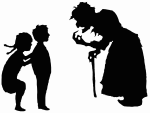The Candy House
| The Candy House | |
|---|---|
| Directed by | Walter Lantz[1] Bill Nolan[1] |
| Produced by | Walter Lantz |
| Animation by | Manuel Moreno Lester Kline Fred Kopietz George Grandpre Ernest Smyth |
| Color process | Black and white |
Production company | Walter Lantz Productions |
| Distributed by | Universal Pictures[1] |
Running time | 8:37 |
The Candy House is a 1934 short animated film featuring Oswald the Lucky Rabbit, one of the few in which he plays a character other than himself. The film is an adaptation of the fairy tale Hansel and Gretel by the Brothers Grimm.
Plot
Hansel (Oswald the Lucky Rabbit) and Gretel are two simple children who live with their father and stepmother. Although they have little resources, they are happy. One day the stepmother is irritated by the food shortage, and makes the children go to bed without dinner. The stepmother then talks to the father about taking the children deep in the forest to be abandoned. The father is too timid to argue. Hansel and Gretel overhear their conversation.
The next day, the stepmother takes the children further in the forest. Hansel picks up a sunflower, and drops its seeds on the way to mark their path. When they reach a certain distance, the stepmother tells them to cover their eyes, pretending she has a surprise for them. When she makes the run, Hansel is optimistic that he and his sister would have no trouble getting home. But to their dismay, birds have eaten the sunflower seeds.
With their trail cleaned off, Hansel and Gretel are left wondering how they can get back. After walking around for a few moments, they come across a cottage made of candy. They then start eating pieces of the house. While they are still eating, a voice invites them to come in. Upon entry, the two little rabbits are met by a hag who grabs them.
The hag appears to be more interested in Hansel as she has him placed in a cage to be fed. Gretel, however, is hung onto a column, reserved for a later purpose. The hag offers Hansel a whole roasted turkey. She then discloses she would make a meal out of him if Hansel gains some weight. Hansel, who dislikes her plans, lets a rat eat his food. The hag then picks up Hansel again, and tries to stuff him in the oven. Hansel, however, is able to get out of her grasp and run. He then helps bring down his sister. After a few chases, the little rabbits manage to trick the hag into running into the oven.
Back at home, the father laments for the lost children but the stepmother shows no regret. In no time, the parents hear singing voices coming from outside. To the parents' surprise, Hansel and Gretel return home somehow. Hansel and Gretel also brought stuff to eat as they even brought with them the entire candy house. The stepmother also comes forward to apologise for her deed.
References
- ^ a b c d The Canadian Patent Office Record and Register of Copyrights and Trade Marks, vol 62, issues 1-4. Patent Office. 1934. p. viii.
- ^ Webb, Graham (2000). The Animated Film Encyclopedia: A Complete Guide to American Shorts, Features and Sequences 1900-1979. McFarland. p. 76. ISBN 9780786407286. Retrieved 20 January 2016.
External links
- 1934 films
- 1934 animated films
- 1930s American animated films
- 1930s animated short films
- American films
- American black-and-white films
- Films directed by Walter Lantz
- Oswald the Lucky Rabbit cartoons
- Animated buddy films
- Universal Pictures films
- Films based on Hansel and Gretel
- Films based on fairy tales
- Walter Lantz Productions shorts
- Films about rabbits and hares
- Animated films about animals
- Short animated film stubs

